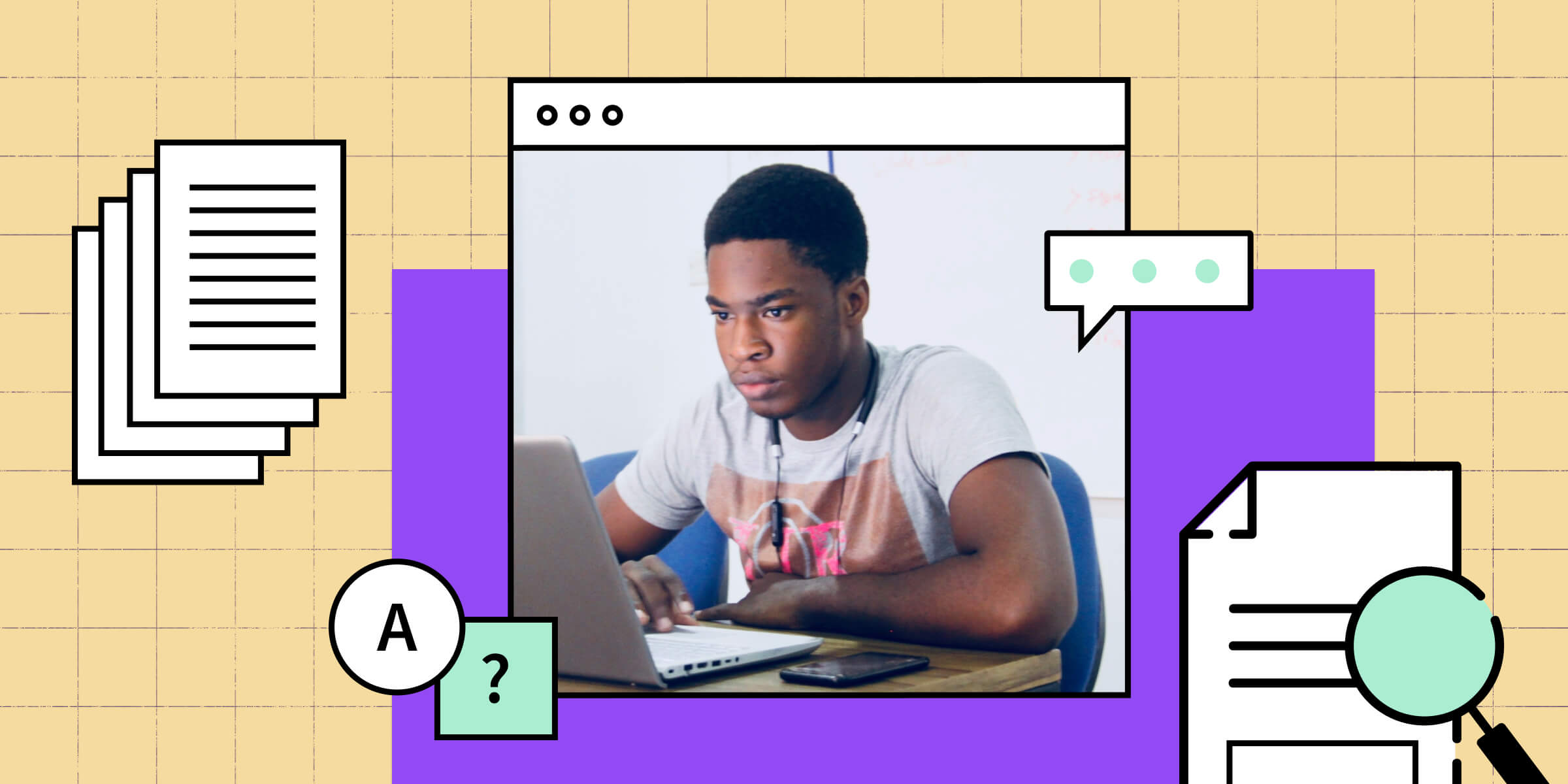Stemming from the Discovery Learning movement of the 1960s, the Inquiry-Based Learning (IBL) Model is a pedagogy that centers on the belief that people learn best through social experiences and by investigating problems and situations themselves.
Educators using the inquiry-based model encourage students to conduct experiments and investigations to expand their knowledge base. In turn, learners develop critical thinking, collaboration, communication and problem-solving skills that will serve them well, not just in higher education, but in the workplace as well.
Table of Contents
- What inquiry-based learning means
- Why inquiry-based learning is important in higher education
- The five steps of inquiry-based learning in higher education
- The four forms of inquiry in higher education
- How inquiry-based learning helps with blended and online learning in higher education
- Conclusion
What inquiry-based learning means
Underlying inquiry-based learning is four fundamental principles:
- Students are central to the learning process. Educator involvement, technology and other learning resources are specifically geared around student participation and engagement.
- Every learning activity centers on answering students’ questions and strengthening their information-processing abilities.
- In addition to facilitating the learning process, educators should aim to learn about their students personally and enable them to apply inquiry-based learning as learning unfolds.
- Educators should not overemphasize the content of the particular subject or field of study. Instead, they should focus on evaluating student progress in developing information-processing abilities and conceptual comprehension throughout the learning process.
Why inquiry-based learning is important in higher education
Inquiry-based learning is designed to engage and harness a student’s intellectual curiosity. It empowers them to lead the course of their own studies. This way, it expands and deepens their understanding and competency, not just with respect to a specific area of study, but the process of learning itself. Through inquiry-based learning, students develop their abilities to question, research and communicate and collaborate both in and out of the classroom.
Inquiry-based instruction is multidisciplinary by nature. When students engage in the process of inquiry, they develop skills that span academia and the workplace. These include collaboration, collecting and analyzing data, developing and organizing representations of that data in order to share the results with others. The greatest value of these activities is helping students understand the practical value of what they are learning.
The five steps of inquiry-based learning in higher education
Although this approach crosses disciplinary boundaries, it generally follows the same set of steps to encourage deeper learning and the development of critical thinking skills.
1. Pose a question
The first phase of IBL may well be the most important. It encourages student engagement by asking learners to formulate the questions they will be exploring and to assess their initial understanding of those questions. This is also the only phase with direct instruction from the educator. This allows them to orient themselves to the topic and to assess their prior knowledge as well as current levels of understanding. From these questions and insights, students can then develop the hypotheses they will investigate.
2. Execute research
In the second phase of IBL, students begin to conduct research and collect data from a variety of reliable and authoritative sources. They also design experiments to test their hypotheses. As students acquire more information and insights, the goal is to reevaluate their initial understandings and determine whether they need to be altered or amended. This prepares students for the next step which involves fully analyzing all the information they’ve collected.
3. Interpret the data
After all the research is completed, including data collection and hypothesis testing, it’s time for the next step. Here, students critically analyze and interpret all the information they’ve collected as a form of experiential learning. The goal here is to use their new understanding of the topic to refine their answers to the questions they initially formulated.
This third phase is also when students begin identifying trends and patterns in the data noting similarities and differences between them. By the end of this phase, students will have synthesized their work to determine and better understand their own perspectives among the broader scope of possible explanations, opinions and theories.
4. Share results
Once students have drawn conclusions from their explorations, it’s time to organize their findings and conceptual understandings in writing or other formats to present them to others. This is the stage where they solicit feedback from their instructor and classmates on their determinations and the work that led them there.
5. Evaluate student learning
This final phase of IBL occurs after the study and research of the initial questions have been completed and shared. In this phase, it is not their new knowledge of a given topic itself students examine. Instead, students evaluate the effectiveness of their process in achieving their learning objectives. Beyond a greater understanding of the material, one of the key benefits of inquiry-based learning is that it allows students to expand their critical thinking, data analysis and communication skills.
Click here to access the 2021 Online Teaching Toolkit to learn how to elevate your teaching practice.
The four forms of inquiry in higher education
In an inquiry-based learning environment, students have the opportunity to fully investigate lines of inquiry, not only to learn from the results but to learn the very process of inquiry itself. There are multiple approaches to do so, each with its own specific style and benefits.
1. Confirmation inquiry
In confirmation inquiry, teachers give students a question and a procedure for discovering the same known answer. In other words, students know ahead of time the result their investigations should reach. The aim of this exercise is not to discover the answer to a question so much as it is to hone a student’s investigative skills. Confirmation inquiry helps teach students to collect and record data and follow procedures.
2. Structured inquiry
In a structured inquiry exercise, educators give students a question with an unknown answer to investigate along with a set of procedures to follow. Structured inquiry helps teach students to collect, record, analyze and evaluate data by following a specific process to formulate explanations by engaging them in educational research.
3. Guided inquiry
In a guided inquiry activity, teachers give students a question with an unknown answer but without a set of procedures to follow. The goal here is to have students explore a question individually or in small groups and design a set of procedures to answer it. Guided inquiry helps students learn the same skills as confirmation and structured inquiry as well as as a set of steps to guide the process.
4. Open inquiry
Also known as true inquiry, open inquiry involves students designing their own points of inquiry and procedures for investigation. Over the course of their inquiry, students must explore and answer the questions they’ve devised. Open inquiry helps students learn the same skills as the other three forms of inquiry as well as devise questions and communicate results.
How inquiry-based learning helps with blended and online learning in higher education
The self-directed nature of the inquiry-based learning model melds well with blended and online learning environments. The primary role of an instructor using IBL is to serve as a guide rather than a direct provider of learning and information. While touchpoints are critical to providing mentorship and guidance, the primary goal is for students to explore, test and analyze what they have uncovered. The remote nature of online and blended learning can actually help empower students to direct their own learning and rely on the instructor less for their own educational progress and development.
4 ways educators can use inquiry-based learning in their higher ed classrooms
- Design thinking: Design thinking is a collaborative, experimentation- and investigation-based process of learning and a great way to develop collaboration, problem-solving and inquiry skills. Whether you implement the design thinking process through an individual project or group activity, you can use it to help students learn to better identify challenges, gather information, design possible solutions, test them and refine their ideas.
- Problem-based learning: This learning and teaching method provides students with complex real-world problems and guides them through the process of discovering the answer to their own satisfaction. The key here is to give students the question(s) before they begin learning anything about the topic or method of deriving a potential solution. This propels students to develop inquiry-related skills such as formulating questions, identifying the information they’ll need and locating, interpreting and using that information to figure out the answer. Students walk away from these experiences better equipped to engage their own thinking to tackle future real-world problems.
- Scenario-based or case-based learning: Give students real-life scenarios to analyze as a group. What’s important to keep in mind is that the case or scenario should have no singular right answer or solution. The instructor’s primary role is to serve as a facilitator. The challenge for participants is to combine their knowledge and skills to analyze and address the case collectively and come up with their own mutually satisfactory solution.
- Meta-questions: These larger questions—or ‘questions about questions’—often take more time and multiple smaller experiments or investigations to answer. This approach allows students to explore and engage in multiple learning experiences in an effort to reach a greater understanding of a more complex topic. The process often spans multiple sessions in which students discuss their progress and participate in new activities that ultimately help them contribute to the larger understanding of the question at hand, as well as their own questions.
Conclusion
Inquiry-based learning is more than asking a student what they want to know. It’s about generating a genuine curiosity and interest in learning. Activating a student’s curiosity is a far more important and complex goal than information delivery. Despite its complexity, inquiry-based learning can be a form of professional development for educators, by encouraging them to be choosy with their formal lecturing and instruction. By releasing some authority to students, members of the class are more likely to feel a sense of ownership over their own learning.


